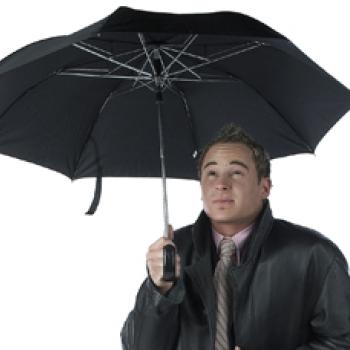Weather Detectives: Questioning the Fact and Folklore of Weather Sayings

- Preview |
- Standards |
- Resources & Preparation |
- Instructional Plan |
- Related Resources |
- Comments
Overview
Before there were weather tools, people looked to the sky, plants, and animals for hints about what the weather would do. To remember these indicators, people coined weather sayings. But are these sayings true and reliable? This lesson explores the truth and reliability of weather-related sayings, such as, “Mare's tails and mackerel scales make tall ships take in their sails.” Students brainstorm weather sayings then investigate the accuracy and origins of the sayings in predicting the weather, using print and online resources in their research. Next, students write about and illustrate their weather sayings then share their results with their classmates. Finally, students discuss skepticism and when it may be a good response to information that is presented to them as fact.
From Theory to Practice
What happens when we invite students to ask questions about the "facts" they hear and read? By encouraging students to adopt a skeptical stance, teachers urge students to keep the inquiry process in motion. In the inquiry-based classroom, students are encouraged to question and explore ideas and skepticism and doubt are the cornerstone of this process.
In "Learning Is Born of Doubting: Cultivating a Skeptical Stance," David J. Whitin and Phyllis Whitin explain that "Learning is born of doubting . . . Skepticism drives a person's need to know, and it contributes to collective understanding. Skepticism is the force that keeps inquiry in motion. Without skepticism, knowledge is reduced to the fossilized remains of unquestioned facts and unchallenged assumptions" (123). Like the birdwatching project that Whitin and Whitin describe, this lesson plan asks students to become "relentless detectives who persist in asking two key questions: Why? and Why not?" (Siegel & Carey, qtd. in Whitin & Whitin, 128).
Further Reading
Common Core Standards
This resource has been aligned to the Common Core State Standards for states in which they have been adopted. If a state does not appear in the drop-down, CCSS alignments are forthcoming.
State Standards
This lesson has been aligned to standards in the following states. If a state does not appear in the drop-down, standard alignments are not currently available for that state.
NCTE/IRA National Standards for the English Language Arts
- 1. Students read a wide range of print and nonprint texts to build an understanding of texts, of themselves, and of the cultures of the United States and the world; to acquire new information; to respond to the needs and demands of society and the workplace; and for personal fulfillment. Among these texts are fiction and nonfiction, classic and contemporary works.
- 3. Students apply a wide range of strategies to comprehend, interpret, evaluate, and appreciate texts. They draw on their prior experience, their interactions with other readers and writers, their knowledge of word meaning and of other texts, their word identification strategies, and their understanding of textual features (e.g., sound-letter correspondence, sentence structure, context, graphics).
- 4. Students adjust their use of spoken, written, and visual language (e.g., conventions, style, vocabulary) to communicate effectively with a variety of audiences and for different purposes.
- 5. Students employ a wide range of strategies as they write and use different writing process elements appropriately to communicate with different audiences for a variety of purposes.
- 6. Students apply knowledge of language structure, language conventions (e.g., spelling and punctuation), media techniques, figurative language, and genre to create, critique, and discuss print and nonprint texts.
- 7. Students conduct research on issues and interests by generating ideas and questions, and by posing problems. They gather, evaluate, and synthesize data from a variety of sources (e.g., print and nonprint texts, artifacts, people) to communicate their discoveries in ways that suit their purpose and audience.
- 8. Students use a variety of technological and information resources (e.g., libraries, databases, computer networks, video) to gather and synthesize information and to create and communicate knowledge.
- 11. Students participate as knowledgeable, reflective, creative, and critical members of a variety of literacy communities.
- 12. Students use spoken, written, and visual language to accomplish their own purposes (e.g., for learning, enjoyment, persuasion, and the exchange of information).
Printouts
Websites
Preparation
- Plan the timing for the lesson. It may be useful to introduce weather sayings on a Friday, for instance, so that students have the weekend to gather sayings from family and friends.
- Before beginning the research portion of this lesson, make sure that the students understand the notetaking process and have a working knowledge of plagiarism. You may use this lesson on research skills as a reference.
- Make the appropriate number of copies of handouts and self-assessment sheets.
- Test the Weather Sayings Travelogue on your computers to familiarize yourself with the tools and ensure that the sites are not blocked by any filtering software.
Student Objectives
Students will:
- select weather sayings to research.
- use print and online resources to verify weather sayings.
- summarize gathered information.
- write about their research.
- create illustrations to match their weather sayings.
Session One
- Ask students what they know about weather sayings and if they’ve ever heard any sayings that “predict” weather.
- As students share sayings, generate a list on chart paper or the board.
- Ask the students their opinions on the weather sayings—Do they think they are true? Could some parts of them be true? Where do they think the weather sayings came from?
- Pass out the Weather Sayings Recording Sheet. For homework, ask students to survey their family and friends for additional weather sayings. Encourage students to survey people from older generations.
Session Two
- Invite students to share the sayings that they've recorded for homework. As students share sayings, add them to the brainstormed list from the previous session.
- Return to the idea whether the sayings are true, asking students to indicate which sayings they believe and which they doubt or are unsure of.
- Encourage students to share the reasons for their opinions and to use data they gathered when they interviewed family and friends.
- Ask students to brainstorm a list of resources that they can consult to find out more about the truth of weather sayings (e.g., books, Internet sources). Collect suggestions on the board or on chart paper.
- Share the Explanations of Weather Sayings (Red Sky and Mare's Tails) with the students, using them as examples for students’ own investigations.
- Ask students to brainstorm a list of qualities that are useful in an explanation of a weather saying, shaping the list into guidelines for students’ research. List these qualitites on the board or chart paper for students to reference later.
- Divide students into groups or pairs and ask each group to choose 3 to 5 weather sayings from the class list or their own Weather Sayings Recording Sheet. Additionally, you can provide the Collection of Weather Sayings to provide more options for students’ choices. You might encourage students to choose sayings that they are particularly skeptical of or sayings that they have a personal connection to.
- Demonstrate the research process for the students, using the example, and demonstrating the Weather Sayings Travelogue, which will walk students through the research process using pre-selected Websites and providing guiding questions.
- Share the Weather Sayings Explanation Rubric and go over the expectations for the finished project. Allow time for students' questions regarding the rubric and grading.
Session Three
- Remind students of the goal of their research and invite them to share any questions that they have about the sayings that they've chosen.
- Provide books, journals, magazines, and field guides, as well as computers with Internet access that students can use as they research their sayings.
- If desired, you might provide students with a mini-lesson on keywords and searching skills.
Session Four
- Provide additional time for research, using the Weather Sayings Travelogue.
- Circulate through the class, providing assistance as students work.
- Remind students to print their Travelogue responses when they are completed. This document serves as an assessment piece of the students’ research.
Session Five
- When the students have completed their research and verification of their selected weather sayings, invite the students to write up their weather findings, on paper or using a word processor, using the Explanations of Weather Sayings (Red Sky and Mares' Tails) as models.
- Invite the students to create illustrations—literal or figurative—to go along with their weather sayings.
- As students complete their final drafts, remind them of the expectations for the finished project, using the Weather Sayings Explanation Rubric.
Session Six
- Allow class time for the students to present their weather sayings, their research, and their illustrations.
- As the students share, ask students to think about the two guiding questions: “Why? and Why not?” Why are some of the sayings reliable? Why not believe them all?
- Work toward gathering some general observations based on the specific weather sayings that students have investigated. Again, the guiding questions are “Why believe sayings?” and “Why not believe sayings?” Encourage students to think about when skepticism is a good response to “facts” that they are presented. Observations may include the following:
- Weather sayings that are based on scientific principles are reliable.
- Weather sayings related to atmospheric conditions, clouds, and direction and winds can be accurate in weather forecasting for specific locations.
- Weather sayings that refer to animals, birds, and insects is sometimes accurate, but cannot be relied upon.
- Location plays a large role in the accuracy of a weather saying. A weather saying that is true in one area may not be true in another area.
- Weather sayings that are based on scientific principles are reliable.
Extensions
- Students can use the Comic Creator to illustrate their weather sayings.
- Invite students to write their own weather sayings, rhymes, or poems. Ask them to illustrate their weather observations as well as to research and explain them.
- An option for illustrating the weather sayings would be to use a digital camera and take photos of applicable weather phenomena, or search for online images depicting the weather sayings. An example can be found on the Library of Congress Website.
Student Assessment / Reflections
- This project requires a variety of informal and formal assessments. Informally, make certain students are on track by:
- listening to the answers they volunteer during class discussions.
- observing their level of participation in discussions, group work, and research.
- using anecdotal note taking or kidwatching to track students’ cognitive skills as they complete the research process.
- interviewing and questioning students throughout the process.
- Formal evaluation may include:
- completed, illustrated weather saying and research, using the Weather Sayings Explanation Rubric.
- inviting students to reflect on what they’ve learned and assess themselves using the Research Self-Assessment.
- responding to the content and quality of students’ thoughts in their final reflections on the project.
